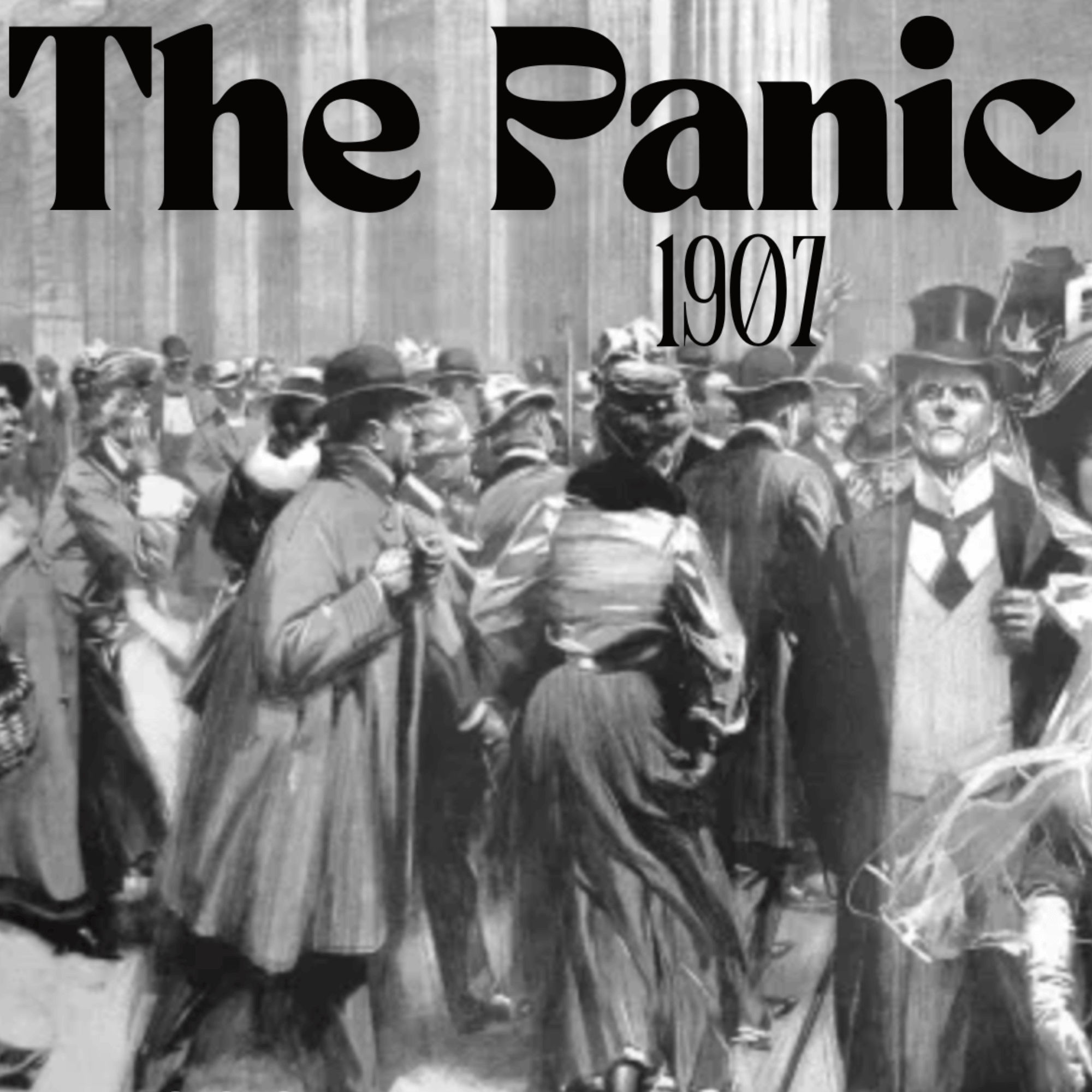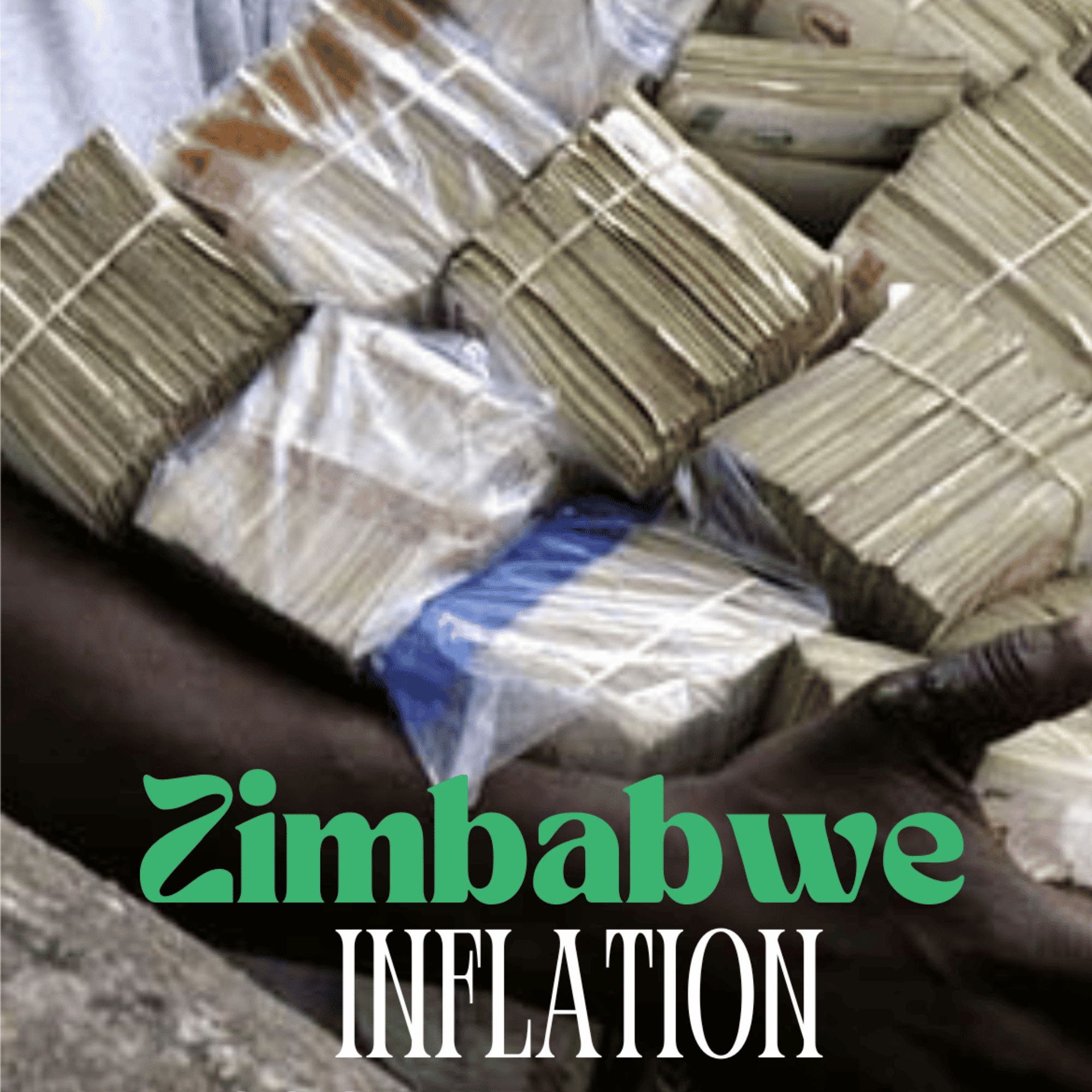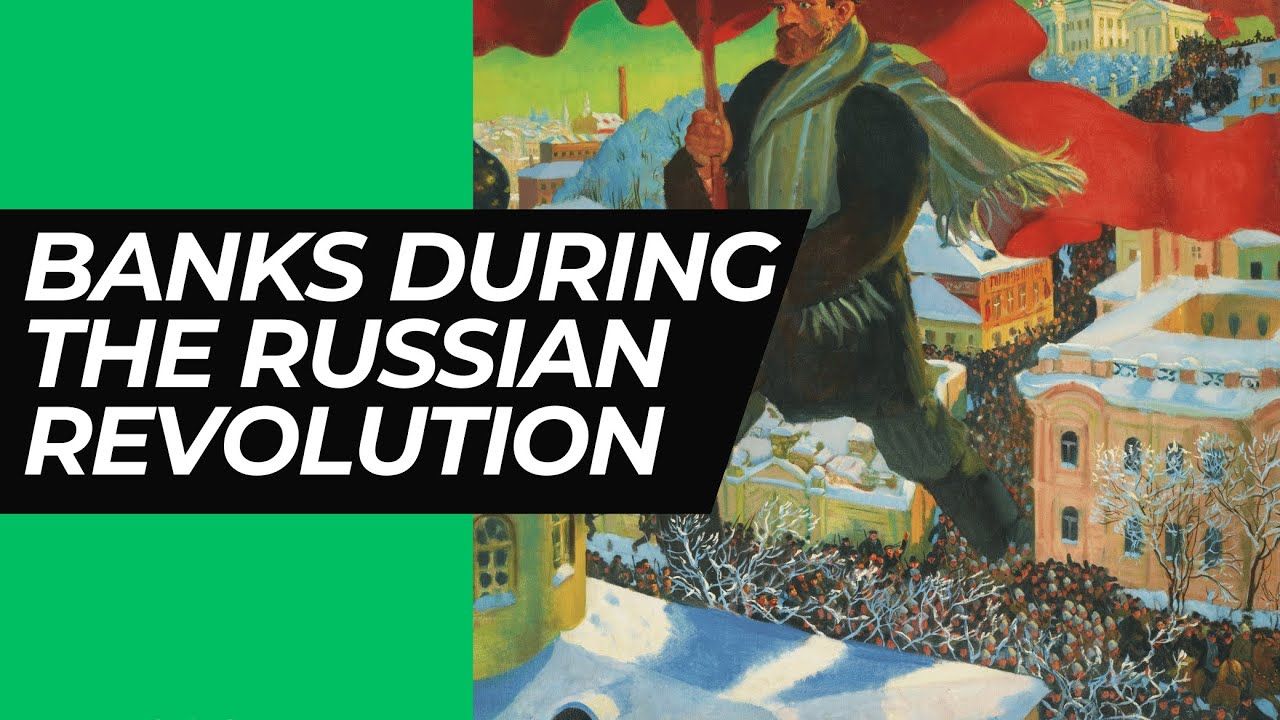
Welcome to "Financial History" Step into the enthralling world of financial history, where money and power collide to shape our world. Each week, we uncover extraordinary stories—from the game-changing deals of modern times to the ingenious financial practices of ancient empires. Explore the tales behind market booms and busts, groundbreaking innovations, and the financial masterminds who redefined economies across centuries. Every episode is a time capsule, bringing the past to life with lessons and intrigue. Don't miss out on the drama, insights, and timeless lessons of "Financial History." #NEW EPISODES WEEKLY
Alle Folgen
What Happened When Bread Cost Millions in Germany?
During the early 1920s, Germany was plunged into unprecedented economic and political chaos following its defeat in World War I. The Weimar Republic faced mounting pressures from the Treaty of Versailles, social unrest, and a shattered economy. As the value of the German mark collapsed under the weight of reparations and excessive money printing, hyperinflation consumed the nation. In 1923, the situation reached a crisis point: prices skyrocketed, savings evaporated, and basic goods became unaffordable. In this desperate environment, local municipalities and businesses issued Notgeld—emergency money—as a temporary solution to facilitate trade. These colorful and often artistically designed notes provided an alternative means of transaction, reflecting local culture and history. Known for their variety and serial issuance, Notgeld helped communities maintain a sense of economic function amid national collapse. Two central figures in this chapter were Rudolf Havenstein, president of the Reichsbank, who oversaw emergency monetary policies, and Hermann Josef Abs, a young banker who supported innovative financial responses. Their actions symbolized the broader struggle between traditional economic principles and survival-driven innovation. Notgeld issuance became a cultural and economic phenomenon, illustrating both creativity and crisis. While it allowed daily life to continue, it also contributed to further inflation and economic instability. This video explores the historical context, causes, and consequences of Germany’s emergency money, a potent symbol of the Weimar Republic’s collapse and a cautionary tale for financial governance.

The Railway Mania of the 1840s
The setting is Britain during the early to mid-19th century, a time marked by rapid industrialization and technological innovation. Politically, this period was characterized by relative stability under the long reign of Queen Victoria, beginning in 1837, which led to the era being named the Victorian Era. Britain was emerging as a global superpower, driven by its vast empire and booming industrial economy. However, this prosperity was unevenly distributed, with a stark divide between the wealthy elite and the working poor. Economically, the country was experiencing the effects of the Industrial Revolution, which had transformed the manufacturing landscape and fueled urbanization. Factories and mills were springing up, and a new middle class of industrialists and entrepreneurs was rising. However, this rapid economic change also led to challenging working conditions, with long hours, child labor, and minimal wages being commonplace for many. Socially, this era was defined by a rigid class structure. The upper classes enjoyed significant wealth and privilege, while the working class, which had migrated in large numbers from rural areas to cities in search of employment, faced harsh living conditions in crowded and often unsanitary urban environments. This disparity fueled social unrest and calls for reform, leading to movements like Chartism, which sought to improve political representation and workers' rights. Culturally, there was a fascination with progress and innovation. The Great Exhibition of 1851, held in London, celebrated the technological achievements of the era, showcasing inventions and industrial products from around the world. The mood of the time was one of optimism about the potential of technology and industry to improve lives, although this was tempered by anxieties about social change and the impacts of rapid urbanization...

The Panic of 1907
The early 20th century in the United States was a period marked by significant transformation, characterized by rapid industrial growth, increasing urbanization, and the emergence of a more complex financial system. At the turn of the century, the United States was experiencing a shift in its political landscape, moving from a more agrarian society towards an industrial powerhouse. The Progressive Era was gaining momentum, focusing on reforming the government and addressing social issues such as labor rights, women's suffrage, and corporate monopolies. President Theodore Roosevelt was in office, advocating for trust-busting and regulatory measures aimed at curbing the excesses of big business. This era also saw tensions related to labor strikes and the rise of labor unions, as workers demanded better wages and working conditions. Economically, the country was transitioning from a predominantly agrarian economy to an industrialized one. The United States was becoming a major player in global trade, fueled by technological advancements like the telegraph and railroad systems, which improved communication and transportation. The economy, however, was not without its challenges. The financial system was still largely unregulated, leading to speculative investments and frequent bank failures. Economic growth was often accompanied by instability, as evidenced by earlier financial panics in 1873 and 1893. Socially, the early 1900s were defined by stark contrasts between wealth and poverty. While industrialists amassed fortunes, many workers faced grueling labor conditions for meager wages. Immigrant populations flocked to urban centers, contributing to a diverse cultural landscape but also facing discrimination and challenges in assimilation. Daily life for the common person often revolved around long work hours in factories, with little regard for safety or health. Labor strikes were common as workers organized for better conditions, often clashing with law enforcement and industrialists. Culturally, this period was vibrant, with movements in literature, art, and music reflecting the complexities of modern life. The rise of mass media, including newspapers and magazines, influenced public opinion and fostered a sense of shared national identity. Technologically, innovations such as the telephone and electricity were transforming daily life, making urban living more manageable and connected. Overall, the early 1900s were a mix of prosperity and turmoil. The optimism of the industrial age was palpable, yet it was tempered by the realities of economic inequality and the struggles of the working class. The nation was on the cusp of significant change, and the events leading to the Panic of 1907 would further highlight the vulnerabilities of an evolving financial system. As financial instability loomed, the public grew increasingly anxious, setting the stage for one of the most consequential financial crises in American history...

The issuance of serial emergency money
The political landscape of Germany in the 1920s was characterized by instability and fragmentation following the end of World War I. The Weimar Republic, established in 1919, faced immense challenges as it sought to rebuild the nation amidst widespread dissatisfaction. The Treaty of Versailles, which imposed heavy reparations on Germany, fueled resentment and was perceived as a humiliation. This led to the rise of various political factions, from radical leftists to nationalist groups, each vying for power and influence. Frequent changes in government, along with attempts at coups such as the Kapp Putsch in 1920, created a climate of political uncertainty. The political turmoil was compounded by ongoing social unrest, as many Germans struggled to accept the loss of the war and the economic hardships that followed. The fear of communism, spurred by the Russian Revolution in 1917, also loomed large, leading to a climate of suspicion and conflict between various ideological factions within society. Economically, the early 1920s were marked by severe instability. The aftermath of the war left Germany’s economy in ruins, with significant damage to infrastructure and industry. The government resorted to printing money to meet its reparations obligations and fund reconstruction, which led to rampant inflation. By the early 1920s, hyperinflation had begun to take hold, eroding the value of the German mark and decimating savings for the middle class. This period of hyperinflation reached its zenith in 1923, when prices skyrocketed, and people struggled to afford basic necessities. The value of money plummeted so drastically that ordinary transactions required wheelbarrows full of cash, and many people resorted to bartering or using alternative forms of currency. This economic chaos created an environment where survival became a daily challenge for many...

The Bank of England
The late 17th century was a period of significant political turmoil in England. The English Civil War (1642-1651) had left a lasting impact, leading to the establishment of the Commonwealth under Oliver Cromwell and the subsequent restoration of the monarchy in 1660. The Glorious Revolution of 1688 marked another pivotal moment, as William of Orange took the throne, which established parliamentary supremacy and limited the powers of the monarchy. This political environment fostered an increasing need for financial stability and a reliable banking system, culminating in the founding of the Bank of England in 1694. Economically, England was experiencing a transitional phase. The late 17th century saw the rise of mercantilism, where the government sought to accumulate wealth through trade and commerce. However, this was also a time of economic instability characterized by fluctuations in currency value, particularly with the use of coins. The scarcity of precious metals and the rampant clipping of coins (shaving edges to create counterfeit money) led to a devaluation of currency, causing confusion and distrust among the populace. In 1690, England faced a severe financial crisis due to costly wars, particularly the Nine Years' War against France (1688-1697). The government struggled to finance military expenditures, leading to an increased need for loans and a stable currency to support economic activity. Socially, England was stratified into distinct classes. The nobility and wealthy merchants thrived, while the common people faced daily challenges such as high taxation and the effects of inflation on wages and food prices. The agrarian economy was predominant, with most people living in rural areas and relying on agriculture for their livelihoods. The rise of cities and urban centers, however, marked the beginning of a shift toward industrialization, leading to increased opportunities for trade and commerce. The average person's daily life revolved around agriculture and local markets. While many were engaged in subsistence farming, townsfolk depended on trade for goods not produced locally. As the economy began to diversify, so did the need for a stable medium of exchange, which the Bank of England sought to provide...

South Sea Bubble
At the time of the South Sea Bubble, Great Britain was under the reign of King George I, who ascended the throne in 1714 following the death of Queen Anne. This period was defined by political tensions between the Whigs and Tories, the two dominant political parties. The Whigs favored a more centralized government and commercial expansion, while the Tories were more conservative and supported the monarchy and traditional social structures. The political atmosphere was also influenced by the ongoing struggles for power between Parliament and the monarchy, leading to a growing sense of parliamentary democracy. Simultaneously, Britain was involved in the War of the Spanish Succession (1701-1714), which had considerable economic implications. This conflict pitted several European powers against each other, resulting in high military expenditures that strained the British economy. Following the war, the Treaty of Utrecht (1713) brought relative peace, but the nation faced the challenge of managing its national debt, which had surged due to war financing. The early 18th century was a period of significant economic transition. Britain was beginning to emerge as a global trading power, aided by the expansion of its colonial empire. The South Sea Company, established in 1711, was emblematic of this growth, aiming to trade in the lucrative South American markets. However, the broader economy was still grappling with the aftereffects of war, including inflation and financial instability. Trade and commerce were increasingly important to the British economy, and new financial instruments, such as stocks and shares, began to take root. The concept of speculative investment emerged, driven by a growing middle class eager to engage in trade and commerce. This shift toward speculation and investment was coupled with a burgeoning interest in finance, leading to the rise of investment firms and stock exchanges. The social structure of early 18th-century Britain was rigidly hierarchical, with a clear divide between the aristocracy, the growing merchant class, and the working poor. The Industrial Revolution was still on the horizon, and most people lived in agrarian societies, relying on farming for their livelihoods. However, urbanization began to take hold, particularly in cities like London, where economic opportunities attracted rural inhabitants...

Rice and Riches
The Dōjima Rice Exchange, established in 1730 in Osaka, Japan, was a crucial milestone in the history of Japanese commerce and finance. To understand its significance, we must explore the broader historical context of Japan during the Edo period (1603-1868), a time characterized by peace, stability, and economic growth following centuries of civil strife. The Edo period was marked by the Tokugawa shogunate's rule, a feudal military government that centralized power and imposed strict social hierarchies. The shogunate established a relatively peaceful environment, reducing the risk of war and allowing for economic prosperity. However, this stability came at a cost: the rigid class system restricted mobility and dictated the lives of the samurai, farmers, artisans, and merchants. Political power was concentrated in the hands of the samurai class, while the merchant class, although financially powerful, remained socially subordinate. The economy of Edo-period Japan was largely agrarian, with rice serving as both a staple food and a form of currency. Agricultural productivity increased due to advancements in farming techniques and the introduction of new rice varieties. This boost in production allowed for the growth of urban centers, particularly Osaka and Edo (modern-day Tokyo), which became bustling trade hubs. The establishment of the Dōjima Rice Exchange facilitated the trading of rice as a commodity, creating a more sophisticated market system. The exchange was essential for stabilizing rice prices and fostering speculation, reflecting broader changes in economic practices and the emergence of a commercial culture. The social structure of Edo Japan was hierarchical, with samurai at the top, followed by farmers, artisans, and merchants. The majority of the population were farmers who faced the dual challenges of unpredictable weather and heavy taxation. Daily life for common people involved agricultural labor, subsistence farming, and participation in local festivals. The samurai class, while politically powerful, adhered to a strict code of honor and duty, often living in urban centers while their families remained in the countryside. The merchant class, despite being considered the lowest of the four main classes, played a pivotal role in the economy. They facilitated trade and commerce, accumulating wealth that often surpassed that of the samurai. However, merchants were still restricted by social norms that dictated their lifestyle and interactions. Cultural expressions flourished during this period, with the rise of ukiyo-e (woodblock prints), kabuki theater, and the development of a rich literary tradition, reflecting the vibrant urban life and the emerging consumer culture.

Kipper and Wipper
The early 17th century in Europe was marked by political fragmentation and turmoil, particularly in the Holy Roman Empire, where numerous principalities and kingdoms were vying for power. The Thirty Years' War (1618-1648), which began just a few years after the Kipper und Wipper events, loomed large in the background. This conflict would soon engulf much of Central Europe, leading to widespread destruction and significant shifts in political power. The religious tensions between Protestants and Catholics played a crucial role in this strife, influencing alliances and hostilities across the region. The economic climate during this period was characterized by instability and transformation. The late 16th and early 17th centuries saw the gradual decline of the feudal system, as rising merchant classes and the beginnings of capitalism started to reshape the economy. However, this transition was fraught with difficulties, including inflation, currency devaluation, and the impact of international trade dynamics. The introduction of new trade routes and commodities from the Americas began to influence local economies, but the widespread reliance on silver and precious metals also led to volatility. The social structure of early 17th-century Germany was hierarchical, with a distinct divide between the nobility and the common people. While the aristocracy enjoyed wealth and power, the peasantry faced hardships, often living in poverty and working the land under feudal obligations. The rising merchant class began to gain prominence, challenging traditional social norms and fostering new economic opportunities. Daily life for the common people was characterized by agrarian lifestyles, with most individuals engaged in farming or artisan crafts. Communities were often tight-knit, with social norms emphasizing family ties and local traditions. However, these communities also faced significant challenges, such as famine, disease (including outbreaks of the plague), and the pressures of a changing economy. Culturally, the era was defined by the Renaissance's legacy, leading to advancements in art, science, and philosophy. The Protestant Reformation, which began in the early 16th century, continued to influence societal values and conflicts, promoting literacy and individual interpretation of scripture. This period also saw the rise of humanism, encouraging a shift in focus from religious to secular subjects in art and education. Technologically, Europe was beginning to experience the early stages of the Scientific Revolution, which would later lead to profound changes in various fields, including navigation, agriculture, and manufacturing. Innovations in technology were slowly permeating daily life, although many rural communities remained insulated from these changes...

Hyperinflation in Zimbabwe
In the late 20th century, Zimbabwe was marked by a tumultuous political landscape. After gaining independence from British colonial rule in 1980, the country was led by Prime Minister Robert Mugabe and his party, the Zimbabwe African National Union-Patriotic Front (ZANU-PF). Initially celebrated for its liberation struggle and educational reforms, Mugabe's government increasingly turned authoritarian over the years. By the late 1990s and early 2000s, opposition to Mugabe’s regime grew, culminating in the formation of the Movement for Democratic Change in 1999. The political environment became increasingly polarized and violent, with the government responding to dissent with crackdowns and allegations of human rights abuses. Electoral disputes further destabilized the country, especially the contested elections in 2000 and 2002, which were marred by violence and alleged fraud. During the 1990s, Zimbabwe experienced a sharp economic decline. Initially one of the more prosperous countries in Africa, the economy began to suffer due to a combination of factors, including poor agricultural policies, land reform initiatives, and the legacy of colonialism. The Fast Track Land Reform Program initiated in 2000 aimed to redistribute land from white commercial farmers to black Zimbabweans. While it was intended to rectify historical injustices, the abrupt and often violent implementation led to a collapse of the agricultural sector, which was vital to the economy. Hyperinflation began to spiral out of control in the early 2000s, reaching astronomical levels. By 2008, Zimbabwe's inflation rate was estimated to be in the millions of percent, effectively rendering the Zimbabwean dollar worthless. The economy became characterized by scarcity of basic goods, rampant unemployment, and declining industrial output. The social fabric of Zimbabwe was deeply affected by the economic crisis and political instability. The widespread poverty resulting from hyperinflation significantly altered daily life. Many families struggled to afford basic necessities, including food, healthcare, and education. Malnutrition rates soared as the agricultural crisis led to food shortages, forcing many to rely on international aid. Social norms began to shift as desperation took hold. Barter systems emerged as the currency lost value, with people exchanging goods and services directly. Informal markets proliferated, allowing citizens to circumvent shortages and the collapsing economy. However, this led to a further erosion of formal economic structures and government authority. For the average Zimbabwean, daily life became increasingly difficult. The scarcity of essentials meant long lines at shops and fuel stations, where people would wait for hours, often only to find empty shelves. Hyperinflation made prices volatile, changing several times within a single day, which made budgeting impossible. As a result, many people turned to the black market, where prices were often exorbitantly high, but goods were available. Healthcare systems suffered greatly during this time. Hospitals were underfunded, and essential medical supplies became scarce. Many healthcare professionals left the country in search of better opportunities, exacerbating the public health crisis...

The Establishment of the Bank of Finland (1812)
The Establishment of the Bank of Finland (1812) and Its Role in Finnish History It's the early 19th century, and Finland is at a crossroads in its history. After centuries of Swedish rule, the region finds itself under the control of the Russian Empire following the Finnish War of 1808-1809. With the winds of change blowing across Europe, Finland's new rulers are keen to modernize and develop the region's economy. Against this backdrop of political upheaval and transformation, the idea of establishing a central bank for Finland begins to take shape. Recognizing the need for a stable and reliable financial institution to support economic growth and development, Finnish authorities embark on a bold venture to create the Bank of Finland. In 1812, amidst the turmoil of the Napoleonic Wars raging across Europe, the Bank of Finland is officially founded, with a mandate to issue currency, manage the national debt, and promote economic stability. Its establishment marks a significant milestone in Finland's journey towards nationhood, symbolizing the country's aspirations for economic independence and self-determination. As the Bank of Finland begins its operations, it faces a myriad of challenges and obstacles. Operating in a time of economic uncertainty and geopolitical turmoil, the bank must navigate a complex web of political pressures and financial constraints. Yet, through determination and perseverance, the bank emerges as a pillar of stability in Finland's evolving economic landscape. Over the years, the Bank of Finland plays a crucial role in supporting Finland's economic development and stability. From financing infrastructure projects to facilitating trade and commerce, the bank's influence extends far beyond its role as a financial institution. It becomes a symbol of Finnish resilience and determination, standing as a testament to the country's ability to thrive in the face of adversity. Positive Aspects: Economic Stability: The establishment of the Bank of Finland in 1812 brought about greater economic stability to the region. As the central bank, it played a crucial role in issuing currency, managing the national debt, and regulating the financial system. By providing a reliable and stable monetary framework, the bank helped foster confidence among investors and promoted economic growth and development in Finland. Facilitation of Trade and Commerce: The Bank of Finland facilitated trade and commerce by providing financial services such as credit and currency exchange. Its role in financing international trade transactions and supporting commercial enterprises helped stimulate economic activity and expand Finland's trading networks. This, in turn, contributed to the growth of Finland's economy and increased prosperity for its people. Infrastructure Development: The Bank of Finland played a significant role in financing infrastructure projects that were vital for the development of the country. By providing funding for projects such as roads, railways, and ports, the bank contributed to the modernization and expansion of Finland's infrastructure network. This improved connectivity and accessibility, facilitating trade, commerce, and social development across the country...

The Issuance of the First Paper Currency in France (18th Century)
The Issuance of the First Paper Currency in France (18th Century) During the Revolution Picture yourself in the heart of the 18th century, a time of enlightenment, revolution, and the birth of new ideas. But amidst the fervor for change, a financial experiment unfolded that would shake the very foundations of society: the issuance of the first paper currency in France during the Revolution. Let us cast our minds back to the France of the late 1700s, a nation on the brink of transformation. It was an era of social inequality, where the aristocracy reveled in luxury while the common folk toiled under the weight of heavy taxation and oppression. The Enlightenment had ignited flames of revolution, inspiring cries for liberty, equality, and fraternity to echo across the land. Against this backdrop of upheaval, the stage was set for a financial revolution that would echo through the corridors of power and resonate with the common man. Amidst the clamor for change, the French government faced a dire fiscal crisis. Wars, extravagant spending by the monarchy, and a faltering economy had left the treasury depleted and the nation on the brink of bankruptcy. In a bold move to stabilize the economy and fund its ambitious endeavors, the government turned to a novel solution: the creation of paper currency. But this decision was not without its risks. The concept of paper money was still relatively new, and its value was inherently tied to the trust and confidence of the people. Would the citizens of France embrace this new form of currency, or would it lead to economic chaos and ruin? As the first notes of paper currency rolled off the presses, they bore the weight of the nation's hopes and fears. Little did anyone know that these seemingly innocuous pieces of paper would soon become instruments of power, greed, and ultimately, revolution. The issuance of the first paper currency in France during the 18th century Revolution brought both positive and negative consequences, leaving an indelible mark on the nation's history. Negative Aspects: Hyperinflation and Economic Instability: One of the most significant negative consequences was the rampant hyperinflation that ensued. The flood of paper money into the economy without proper backing or regulation led to a devaluation of the currency. Prices skyrocketed, causing immense hardship for ordinary citizens who found their savings and wages rapidly diminishing in value. Social Unrest and Discontent: The economic turmoil exacerbated existing social inequalities and fueled widespread discontent among the populace. The burden of inflation fell disproportionately on the poor and working-class, leading to increased social unrest and resentment towards the government and the aristocracy. Loss of Trust in the Currency and Government: The failure of the paper currency experiment eroded public trust in both the currency and the government's ability to manage the...

The Establishment of the Vienna City Bank (1855)
The Establishment of the Vienna City Bank (1855) and Its Role in Financing Infrastructure Projects It's the mid-19th century, and Europe is undergoing a period of rapid urbanization and industrialization. Vienna, the capital of the Austrian Empire, is experiencing unprecedented growth as its population swells and its economy flourishes. Yet, amidst this bustling metropolis, there exists a pressing need for modern infrastructure to support its expanding urban landscape. Against this backdrop of progress and change, a group of visionary individuals comes together with a bold idea: to establish a bank dedicated to financing the infrastructure projects that will shape the future of Vienna. Thus, in 1855, the Vienna City Bank is born, with a mission to provide the capital necessary to build roads, bridges, railways, and other vital public works. But the founding of the Vienna City Bank is not just a story of financial innovation; it's also a reflection of the spirit of collaboration and entrepreneurship that defined the era. As Vienna emerges as a hub of cultural and intellectual exchange, the city's leading figures - from bankers and industrialists to politicians and intellectuals - unite behind the vision of a modern, vibrant metropolis. The establishment of the Vienna City Bank marks a turning point in the history of Vienna, ushering in an era of unprecedented growth and prosperity. With access to reliable financing, infrastructure projects that were once mere dreams become reality, transforming Vienna into a modern, cosmopolitan city that stands as a testament to human ingenuity and ambition. But the impact of the Vienna City Bank extends far beyond the borders of Vienna itself. As word of its success spreads, it inspires similar institutions to be established across Europe and beyond, laying the groundwork for the development of modern banking systems and the financing of infrastructure projects on a global scale. Positive Aspects: Infrastructure Development: One of the most significant positive impacts of the establishment of the Vienna City Bank in 1855 was its role in financing infrastructure projects. With access to capital provided by the bank, Vienna was able to embark on ambitious initiatives to improve its transportation network, build modern bridges and roads, and develop public utilities. These projects transformed Vienna into a modern city with improved connectivity and amenities, enhancing the quality of life for its residents. Economic Growth: The Vienna City Bank played a crucial role in stimulating economic growth by providing funding for infrastructure development. As new transportation routes were established and urban infrastructure improved, economic activities flourished, attracting investments and fostering trade and commerce. The bank's support for infrastructure projects contributed to Vienna's emergence as a thriving economic hub in Central Europe, fueling prosperity and opportunity for its inhabitants. Social Impact: The financing of infrastructure projects by the Vienna City Bank had positive social implications, benefiting various segments of society. Improved transportation networks facilitated mobility and access to essential services, enhancing the overall well-being of Vienna's residents. Additionally, the creation of public utilities such as water and sanitation systems improved public health and sanitation standards, leading to a higher quality of life for the city's inhabitants...

The Impact of the South African Gold Rush
It's the late 19th century, and the world is in the throes of rapid industrialization and expansion. The Industrial Revolution has unleashed unprecedented advancements in technology and infrastructure, driving a hunger for resources to fuel this burgeoning era of progress. It's against this backdrop of innovation and ambition that our story unfolds. Nestled in the heart of southern Africa lies the Witwatersrand Basin, a seemingly unremarkable stretch of land that would soon become the epicenter of a global phenomenon. Little did the world know that beneath the surface of this humble terrain lay vast reserves of gold, waiting to be discovered. As news of the discovery spread like wildfire, prospectors from far and wide flocked to the region in search of fortune and opportunity. What ensued was a frenzied gold rush, as hopeful miners descended upon the Witwatersrand in droves, transforming it into a bustling hive of activity virtually overnight. The influx of fortune seekers brought with it a surge in population, as makeshift towns and settlements sprang up to accommodate the influx of migrants. The once-sleepy landscape was now teeming with life, as miners toiled tirelessly in the depths of the earth, extracting precious gold from its rocky confines. But the impact of the gold rush extended far beyond the borders of South Africa. As word of the bountiful discoveries spread across the globe, it sent shockwaves rippling through the international economy. Investors and speculators clamored to get in on the action, pouring capital into mining ventures and fueling a speculative frenzy that gripped markets far and wide. The sudden influx of gold into the global economy had profound implications, sparking inflationary pressures and reshaping the balance of power among nations. The newfound wealth generated by the gold rush fueled industrial expansion and infrastructure development on a scale never before seen, propelling the world into a new era of prosperity and growth. But with great wealth came great challenges, as the scramble for gold brought with it social upheaval and political turmoil. The exploitation of labor and resources fueled tensions between native populations and European settlers, laying bare the deep-seated inequalities that plagued the era. The South African gold rush of 1886 had both positive and negative impacts on the world economy, shaping global dynamics in profound ways. Positive Effects: Economic Growth: The discovery of gold in South Africa led to a significant increase in global gold supply, contributing to economic growth and prosperity. Gold became a valuable commodity for trade and investment, stimulating economic activity in various sectors. Industrial Expansion: The influx of gold from South Africa fueled industrial expansion worldwide. Gold was used in various industries, including electronics, jewelry, and manufacturing, driving innovation and technological advancement. Infrastructure Development: The wealth generated from the gold rush funded infrastructure projects across the globe. Roads, railways, and ports were constructed to support the transportation of goods, facilitating international trade and commerce. Job Creation: The gold rush created employment opportunities for thousands of people, both in South Africa and beyond. Miners, laborers, and support staff were employed in gold mining operations, stimulating local economies and improving living standards. Negative Effects: Economic Instability: The rapid influx of gold into the global economy led to economic instability and volatility. Speculative bubbles formed in financial markets, leading to boom-and-bust cycles and financial crises. Inflationary Pressures: The sudden increase in gold supply contributed to inflationary pressures in many countries. Rising prices eroded purchasing power and reduced the standard of living for ordinary people, particularly those on fixed incomes. Social Disruption: The gold rush brought social disruption...

The Founding of the First Savings Bank
The Founding of the First Savings Bank in Hamburg (1778) Picture yourselves in the bustling port city of Hamburg, nestled along the banks of the Elbe River in the late 18th century. It was an era of bustling trade, where ships from distant lands docked in the harbor, bringing goods and wealth to this vibrant metropolis. The city teemed with merchants, craftsmen, and sailors, all drawn by the promise of opportunity and prosperity. Amidst the hustle and bustle of commerce, the need for financial services became increasingly apparent. Merchants sought a safe haven to deposit their earnings, while workers dreamed of building a nest egg for the future. It was against this backdrop of economic growth and social change that the idea of a savings bank took root. The year was 1778, and Hamburg was ripe for innovation. Inspired by similar institutions emerging in other European cities, a group of forward-thinking individuals came together to establish the world's first savings bank in Hamburg. Their vision was simple yet revolutionary: to provide a safe and accessible way for ordinary citizens to save and invest their hard-earned money. The founding of the savings bank marked a turning point in the history of banking, ushering in an era of financial inclusion and empowerment for the masses. No longer were banking services the exclusive domain of the wealthy elite; now, even the humblest worker could participate in the growing economy and secure a brighter future for themselves and their families. The founding of the first savings bank in Hamburg in 1778 brought about both positive and negative consequences, reshaping the landscape of financial services and community welfare. Positive Aspects: Financial Inclusion: Perhaps the most significant positive outcome was the newfound access to banking services for a broader segment of society. The establishment of the savings bank provided an avenue for individuals from all walks of life, including the working class and small merchants, to securely deposit their savings and earn interest, fostering financial inclusion and stability. Encouragement of Savings: By offering interest on deposits and providing a safe place to store money, the savings bank incentivized a culture of thrift and savings among the populace. This encouraged responsible financial behavior and helped individuals accumulate capital for future investments, education, or emergencies. Community Development: The savings bank played a pivotal role in fostering community development and investment. By pooling deposits from local residents, the bank could provide loans for local businesses, infrastructure projects, and housing initiatives, stimulating economic growth and improving living standards in Hamburg and its surrounding areas. Stability in Times of Crisis: During periods of economic uncertainty or crisis, the savings bank served as a stabilizing force, providing a safe haven for deposits and liquidity for borrowers. This helped mitigate the impact of financial shocks on individuals and communities, bolstering resilience and confidence in the banking system. Negative Aspects: Limited Accessibility: Despite its pioneering role in promoting financial inclusion, the savings bank may have still been inaccessible to some segments of society, particularly those living in rural or underserved areas. Limited branch networks, stringent eligibility criteria, or cultural barriers may have hindered certain individuals from fully benefiting from the services offered. Risk of Mismanagement: Like any financial institution, the savings bank was susceptible to mismanagement, corruption, or economic downturns. Poor lending practices, inadequate risk management, or external shocks could potentially jeopardize the safety of deposits and undermine public trust in the bank's operations...

The Reichsmark in Germany
The Introduction of the Reichsmark in Germany after World War I (1924) Picture yourself in the tumultuous aftermath of the Great War, a period marked by economic turmoil, political upheaval, and social unrest. The once-mighty German Empire lay defeated and disillusioned, its economy in ruins and its currency rendered worthless by hyperinflation. In this atmosphere of uncertainty and despair, a nation sought to rebuild from the ashes and forge a path towards economic recovery. The year was 1924, and Germany stood on the brink of a new era as it embarked on the ambitious task of reorganizing its monetary system. Against a backdrop of widespread poverty, unemployment, and social upheaval, the Weimar Republic faced the daunting challenge of restoring confidence in its currency and stabilizing its economy. Amidst the chaos and uncertainty, the introduction of the Reichsmark emerged as a beacon of hope for a nation in crisis. Conceived as a symbol of strength and unity, the Reichsmark represented a departure from the hyperinflationary chaos of the past, offering a new beginning for the German people. The world watched with bated breath as Germany embarked on this bold experiment in monetary reform. The success or failure of the Reichsmark would not only shape the economic destiny of Germany but also have far-reaching implications for the stability of Europe and the global financial system. The introduction of the Reichsmark in Germany after World War I in 1924 brought both positive and negative consequences, shaping the nation's economic landscape in profound ways. Positive Aspects: Stability and Confidence: One of the primary objectives of introducing the Reichsmark was to restore stability and confidence in the German economy. By replacing the hyperinflated and practically worthless Papiermark, the Reichsmark aimed to provide a stable medium of exchange, instilling trust among both domestic and international investors. Fiscal Discipline: The introduction of the Reichsmark was accompanied by stringent fiscal policies aimed at curbing inflation and balancing the budget. The German government implemented measures such as tax reforms, spending cuts, and the establishment of an independent central bank to maintain the stability of the currency and restore fiscal discipline. International Recognition: The adoption of the Reichsmark signaled Germany's commitment to fiscal responsibility and financial stability, garnering recognition and support from the international community. This newfound credibility helped Germany regain access to international capital markets and facilitated its integration into the global economy. Modernization of Banking: The introduction of the Reichsmark paved the way for the modernization of Germany's banking system. It led to the consolidation of commercial banks, the establishment of standardized accounting practices, and the adoption of more efficient payment systems, laying the foundation for a more robust and competitive financial sector. Negative Aspects: Social Disruption: The transition to the Reichsmark was not wi...

The Issuance of Royal Coins in Ancient Mali
Picture yourself in the heart of West Africa during this golden age of Mali, a period of unparalleled prosperity and cultural flourishing. It was a time when the legendary city of Timbuktu stood as a beacon of knowledge and trade, attracting scholars, merchants, and travelers from across the known world. Against this backdrop of splendor and opulence, the kings of Mali sought to assert their power and prestige through the minting of their own currency. The practice of issuing royal coins was not merely a symbol of wealth or authority; it was a reflection of Mali's growing influence as a center of commerce and civilization. The coins, crafted from precious metals such as gold and copper, bore the likeness of the reigning monarch and served as a tangible expression of royal authority and legitimacy. As merchants traversed the trans-Saharan trade routes, carrying goods and ideas from distant lands, Mali's royal coins became a currency of choice, prized for their purity and reliability. They facilitated trade and commerce across vast distances, enriching the kingdom and cementing its reputation as a formidable economic power in the region. But the issuance of royal coins was more than just an economic endeavor; it was a statement of Mali's cultural and political identity. The intricate designs and inscriptions adorning the coins celebrated Mali's rich history, folklore, and traditions, immortalizing the achievements of its rulers for generations to come. The issuance of royal coins in ancient Mali from the 13th to the 16th century had both positive and negative impacts on the kingdom and its people. Positive Aspects: Symbol of Prestige and Power: The minting and circulation of royal coins served as a symbol of the wealth, prestige, and power of Mali's rulers. The coins, often crafted from precious metals like gold and copper, bore the likeness of the reigning monarch and conveyed the kingdom's authority to both local subjects and foreign traders. This enhanced Mali's standing on the international stage and bolstered its reputation as a prosperous and influential kingdom. Facilitation of Trade and Commerce: Royal coins played a crucial role in facilitating trade and commerce within Mali and beyond its borders. As a standardized form of currency, recognized and accepted across vast territories, these coins simplified commercial transactions and promoted economic exchange. Traders and merchants traveling along the trans-Saharan trade routes relied on Mali's coins to conduct business, contributing to the kingdom's economic prosperity and fostering cultural exchange. Cultural and Artistic Expression: The minting of royal coins provided an opportunity for artistic and cultural expression in ancient Mali. The intricate designs and inscriptions adorning the coins reflected Mali's rich history, folklore, and traditions. Craftsmen and artisans employed their skills to create coins that celebrated the achievements of Mali's rulers and showcased the kingdom's cultural heritage. These coins served not only as a medium of exchange but also as a means of preserving and disseminating Mali's cultural legacy...

The Development of Trade Cities
The Development of Trade Cities on the Swahili Coast in East Africa Picture yourself standing on the shores of the Indian Ocean, where the warm breeze carries the scent of spices and the sound of bustling markets fills the air. It is here, along the Swahili Coast, that a unique fusion of African, Arab, Persian, and Indian influences gave rise to some of the most dynamic trade cities in history. Our story begins over a millennium ago, in a time when the Indian Ocean served as a bustling maritime highway, connecting distant lands and fostering a vibrant exchange of goods, ideas, and cultures. From the 8th century onwards, Arab and Persian traders ventured southward along the coast of East Africa, establishing thriving trading outposts known as Swahili city-states. These city-states, such as Kilwa, Mombasa, Zanzibar, and Mogadishu, quickly became hubs of commerce, attracting merchants from across the known world. Here, ivory, gold, timber, and spices from the African interior were exchanged for luxury goods such as textiles, porcelain, glassware, and precious metals from the Middle East, India, and China. The Swahili Coast was not merely a center of trade but also a melting pot of cultures and ideas. Over the centuries, Swahili city-states developed a unique blend of African, Arab, and Indian architectural styles, languages, religions, and social customs, creating a rich tapestry of diversity and innovation. As we delve deeper into the history of these trade cities, we witness the ebb and flow of empires, the rise and fall of dynasties, and the resilience of coastal communities in the face of political upheaval and external pressures. Despite the challenges they faced, the Swahili city-states continued to thrive, adapting to changing economic and geopolitical conditions and playing a vital role in shaping the course of history in the Indian Ocean region. The development of trade cities along the Swahili Coast in East Africa brought about both positive and negative consequences, shaping the region's socio-economic and cultural landscape in profound ways. Positive Aspects: Economic Prosperity: Perhaps the most significant positive outcome of the development of trade cities along the Swahili Coast was the economic prosperity they fostered. These cities served as vital hubs of maritime trade, facilitating the exchange of goods and commodities between Africa, the Middle East, India, and China. The influx of trade and commerce stimulated economic growth, created employment opportunities, and generated wealth for merchants, artisans, and local communities. Cultural Exchange: The Swahili Coast's trade cities were melting pots of cultures, languages, and religions, where people from diverse backgrounds interacted and exchanged ideas. Arab, Persian, Indian, and African traders brought with them their respective cultural practices, traditions, and beliefs, leading to a rich tapestry of cultural diversity and syncretism. This cultural exchange contributed to the development of a distinct Swahili culture characterized by its unique blend of African, Arab, and Indian influences...

The Mississippi Bubble
The Mississippi Bubble in France (1719-1720) Picture yourself in the vibrant streets of Paris, the cultural and economic heart of France in the early 18th century. It is a time of great optimism and ambition, as the country emerges from the ashes of war and political upheaval under the rule of the flamboyant Regent Philippe d'Orléans. Against this backdrop of newfound stability and prosperity, a financial revolution is about to unfold, fueled by the dreams of untold wealth and boundless opportunity. The stage is set in 1717 when a Scottish adventurer and financier named John Law arrives in Paris with a revolutionary vision to transform France's economy. Law, a charismatic and enigmatic figure, proposes the creation of a state-backed trading company, the Mississippi Company, with exclusive rights to exploit the resources of the French colony of Louisiana in North America. The lure of riches from the New World captures the imagination of investors, and soon, the Mississippi Company's stock becomes the hottest commodity in town. As news of the company's potential spreads like wildfire, a speculative frenzy ensues, with investors clamoring to buy shares at ever-increasing prices. The streets of Paris buzz with excitement as fortunes are made and lost overnight. Even the nobility and the clergy join the fray, mortgaging their estates and selling their jewels to get a piece of the action. The promise of quick riches blinds investors to the risks, and soon, speculation reaches fever pitch. In 1719, the French government, eager to capitalize on the frenzy, grants the Mississippi Company exclusive trading rights with the lucrative East Indies. The move sends the company's stock soaring to dizzying heights, making John Law one of the wealthiest men in France virtually overnight. But beneath the surface, cracks begin to appear in the facade of prosperity. By 1720, the bubble has reached its breaking point. Concerns about the company's true value and the sustainability of its ventures trigger a panic among investors. In a desperate bid to shore up confidence, Law and the French government resort to drastic measures, including banning the sale of gold and silver, issuing more paper money, and manipulating the stock market. But their efforts are in vain, and in May 1720, the bubble bursts...

Banks during the Russian Revolution
The nationalization of banks during the Russian Revolution (1917) Picture yourself in Russia at the dawn of the 20th century, a land of vast contrasts and simmering discontent. The Russian Empire, ruled by Tsar Nicholas II, was plagued by social unrest, economic inequality, and political repression. The country was on the brink of transformation, with revolutionary fervor sweeping across the land. Against this backdrop of turmoil and upheaval, the Russian Revolution of 1917 erupted like a wildfire, fueled by the aspirations of workers, peasants, and intellectuals for justice, equality, and democracy. In February of that year, mass protests and strikes in Petrograd (now St. Petersburg) led to the overthrow of the Tsarist regime and the establishment of a provisional government. However, the provisional government's grip on power was tenuous, and the stage was set for further upheaval. In October 1917, the Bolshevik Party, led by Vladimir Lenin, seized control of the government in a dramatic coup d'état. With the slogan "All Power to the Soviets," the Bolsheviks embarked on a radical program of social and economic transformation, aiming to dismantle the capitalist system and build a socialist society. One of the key measures taken by the Bolsheviks was the nationalization of banks. In December 1917, the Soviet government decreed the transfer of all banking institutions into state ownership, effectively centralizing control over the country's financial system. This move aimed to break the power of capitalist financiers and establish state control over credit and finance, laying the groundwork for the planned economy envisioned by the Bolsheviks. The nationalization of banks was a pivotal moment in the Russian Revolution, symbolizing the Bolsheviks' commitment to socialist principles and their determination to reshape Russia's economic landscape. However, it also marked the beginning of a protracted struggle to consolidate power, as the new Soviet government faced internal dissent, external threats, and the challenges of governing a vast and diverse country in the midst of war and upheaval. The nationalization of banks during the Russian Revolution of 1917 had both positive and negative consequences, profoundly shaping the course of Russian history. Positive Aspects: Centralization of Economic Control: By nationalizing banks, the Bolshevik government aimed to consolidate control over the country's financial system, centralizing economic decision-making in the hands of the state. This allo...

The Unbelievable Truth Behind Banana Money
The period surrounding the issuance of Banana Money (1942-1945) was marked by significant political upheaval, particularly due to World War II. Following the Japanese invasion of British Malaya in December 1941, the region was occupied by Japanese forces. The occupation represented a drastic shift in power dynamics, as the Japanese military sought to establish control over Southeast Asia, challenging the colonial authority of the British Empire. The political climate was characterized by the imposition of Japanese rule, which included the suppression of local governance and the establishment of a military administration. Economically, the region faced severe disruptions during the Japanese occupation. Prior to the war, Malaya was known for its prosperous rubber and tin industries, which were crucial to the global economy. However, the occupation led to significant economic challenges, including shortages of goods and inflation. The Japanese military administration prioritized the extraction of resources for its war effort, often at the expense of local needs. The introduction of Banana Money was part of a broader strategy to manage the economy and facilitate transactions in an environment increasingly marked by scarcity and instability. Socially, the Japanese occupation drastically altered the lives of the common people. Traditional social structures were upended as the Japanese authorities imposed their governance and sought to integrate the local population into their war economy. Ethnic divisions became pronounced, particularly between Malays, Chinese, and Indians, leading to tensions that would resonate in the post-war period. Daily life for the average person during this time was characterized by hardship and uncertainty. Food shortages, restrictions on movement, and the imposition of curfews were common. Many locals engaged in subsistence farming, while others sought to adapt to the new economic realities by participating in the black market or bartering goods. Cultural practices were disrupted as well, with many festivals and communal activities either canceled or heavily regulated by the occupying forces. Culturally, the Japanese occupation influenced the arts, education, and social norms in Malaya and Borneo. The Japanese promoted their language and culture as part of their assimilation efforts, leading to a forced cultural exchange that altered local customs and practices. While some communities resisted this cultural imposition, others adapted to the new environment, resulting in a blend of traditional and Japanese influences. Technologically, the era was defined by the challenges of wartime conditions. Infrastructure suffered due to bombings and neglect, and the focus was primarily on meeting the immediate needs of the military. However, there were also advancements in communication and transportation, as the Japanese sought to improve logistics for their military operations. The general mood during the Japanese occupation was one of uncertainty and fear. While some segments of the population hoped for liberation from British colonial rule, many others experienced the harsh realities of military occupation, including violence, repression, and economic deprivation. The promises of prosperity and a "Greater East Asia Co-Prosperity Sphere" touted by Japanese propaganda were starkly contrasted by the everyday struggles of the people. Banana Money was a colloquial term used to describe the Japanese military currency introduced in Malaya and Borneo after the Japanese occupation began in December 1941. The term derives from the design of the banknotes, which featured images of bananas, a fruit associated with the region and used symbolically to represent prosperity. The notes were issued in various denominations, with the largest being the 100-dollar bill...
